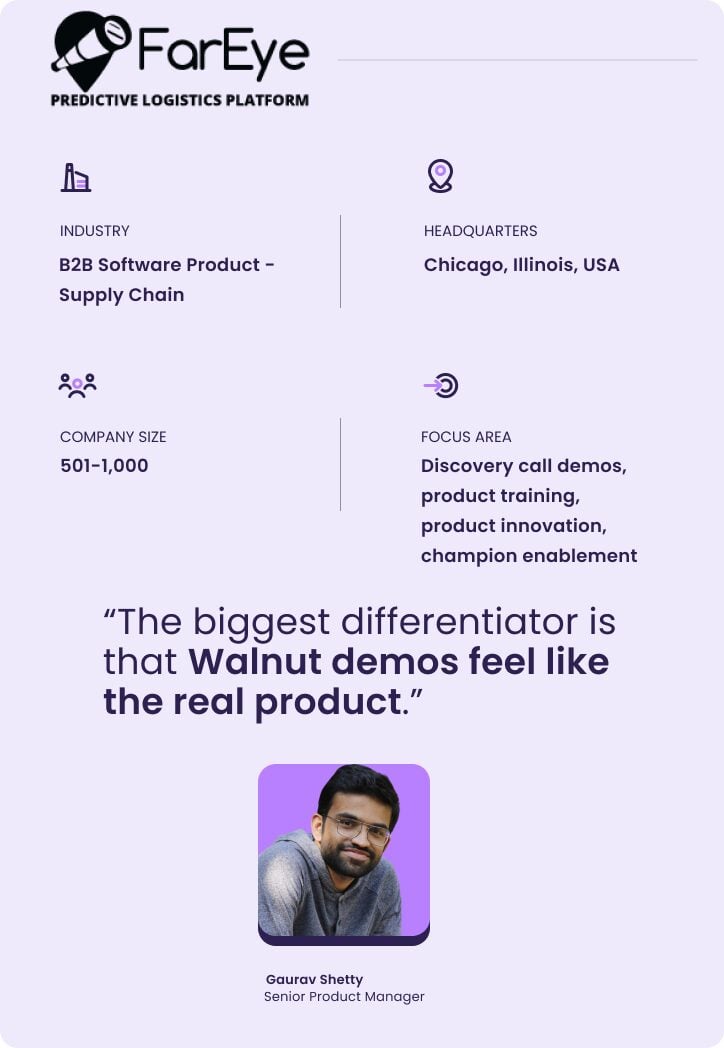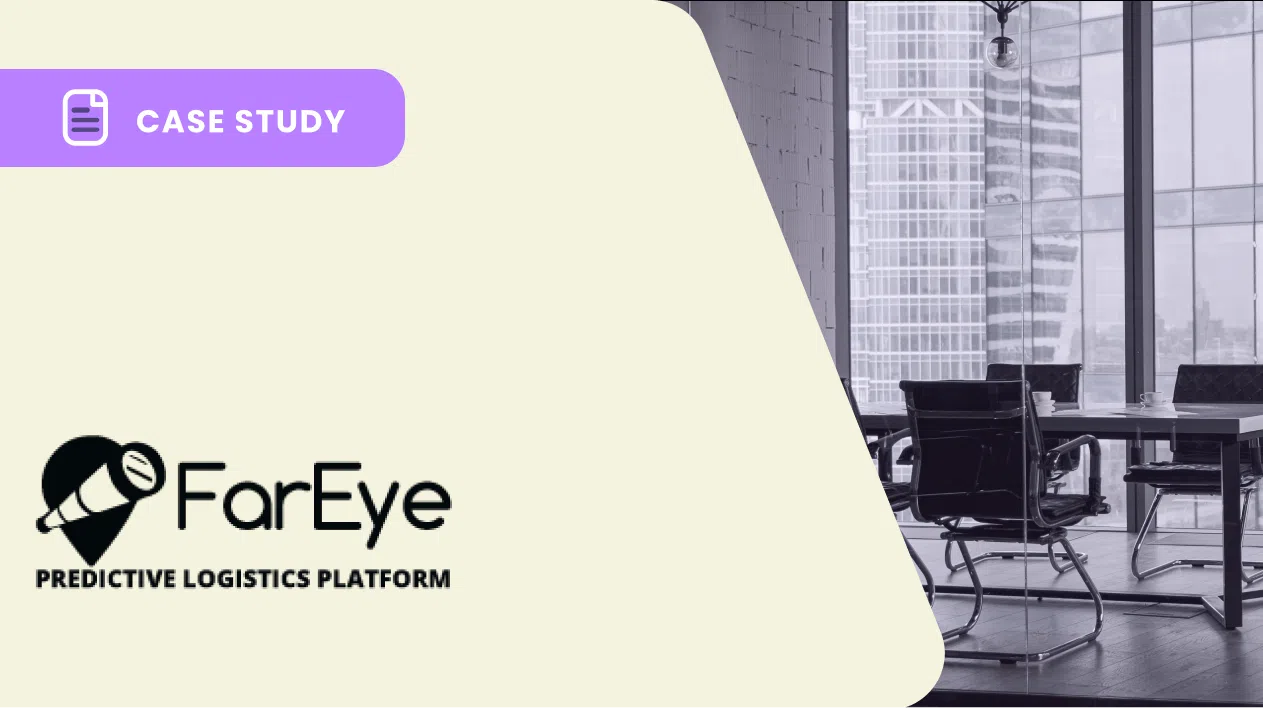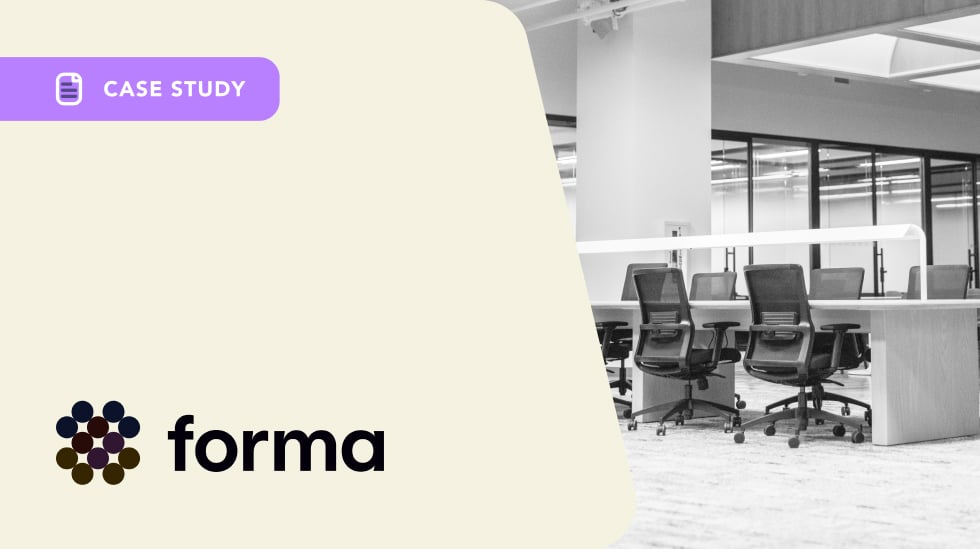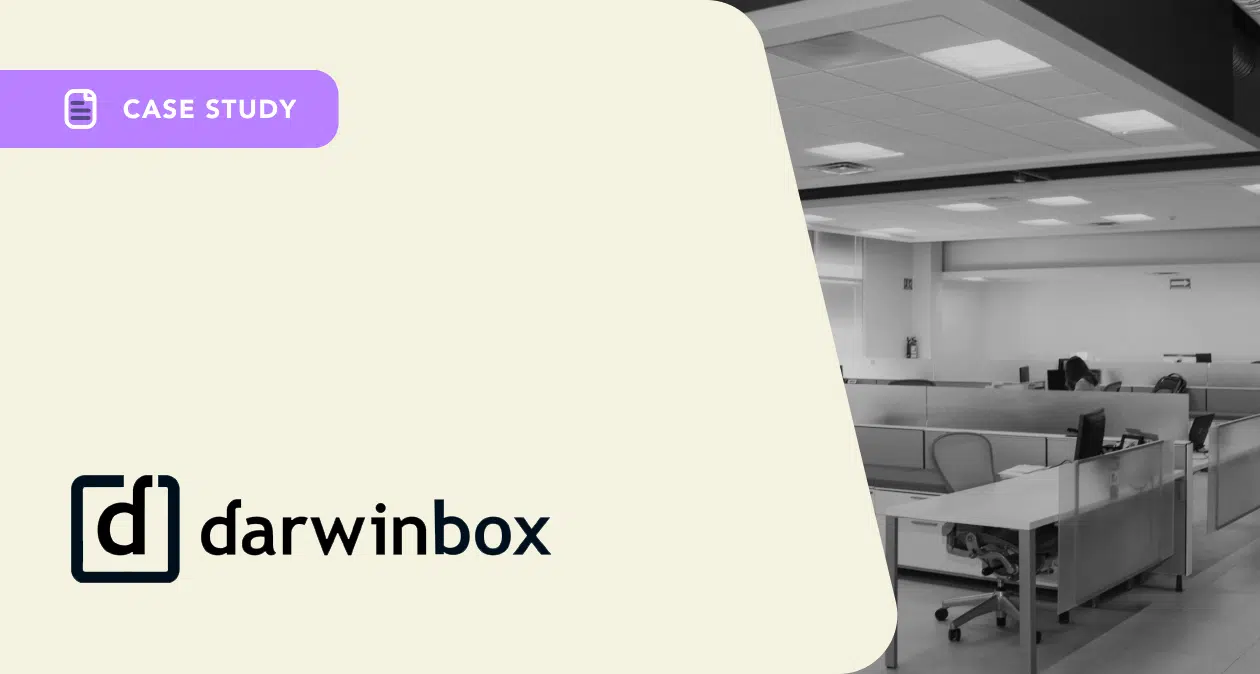
BEFORE WALNUT:
‘We didn’t have any product content to show buyers during the initial period of engagement’
FarEye struggled with long demo setup times because their demos needed to be tailored to their customers’ unique specifications. This meant that during the discovery phase, they didn’t have any product content other than slide decks and their standard offering that the team could use to engage prospects. As a result, it was hard to move prospects from one stage of the sales process to the next.
That’s what drove FarEye to start creating replicas of their products that they could use for demos. However, they soon realized that this took too much time from the team and wasn’t sustainable long-term.
“Because our previous demo setup time was long, we didn’t want to invest too many resources until we verified a prospect had the budget and approvals. But this meant that during the initial period of engagement, we didn’t have any product content to engage prospects.”
AFTER WALNUT:
‘My colleagues could just start using the platform without any training or hand-holding’
From the get-go, FarEye was able to seamlessly implement the platform and onboard the team. And because of the ease of use, they were able to quickly create and distribute demos that could be used during initial conversations with buyers.
“Right away, we noticed that our Walnut demos were much more powerful than the slide decks and standard product screens we were relying on before.”
BUT WAIT, THERE’S MORE:
‘Using Walnut has driven a significant improvement in the conversion rate from sales accepted lead to sales qualified lead’
Beyond the ease at which they were able to implement Walnut, FarEye also noticed a significant improvement in the conversion from sales accepted lead to sales qualified lead. A sales accepted lead has expressed clear buying intent and is ready to talk to a rep, whereas a sales qualified lead has been vetted by the sales team and has entered the sales pipeline.
“We noticed that once we started using Walnut, there was a significant decline in the time it took for prospects to move from one step in the sales process to the next. On top of this, we saw a major improvement in the conversion rate from sales accepted lead to sales qualified lead.”
HERE’S THE FULL STORY:
‘It didn’t make sense for us to invest too much in demo setup until we knew the prospect was serious or that they really had the necessary budget and approvals’
According to Gaurav Shetty, who is a Senior Product Manager at FarEye, one of the major problems that the team faced was that their demo setup time was very long.
This was because of the nature of their product and also the logistics industry itself. For instance, most of the buyers FarEye encounters are enterprise customers who are looking for a specific product that will meet their unique set of specifications, which is dependent on the logistics processes at different firms. Essentially, these customers want the FarEye demo to incorporate these specifications and replicate their processes.
But because setting up these kinds of demos required significant time and resources, the FarEye team didn’t want to invest too much in demo setup until they could qualify the prospect.
‘The only product content we had to show prospects during this initial engagement period was slide decks’
While FarEye didn’t want to invest too much time and resources into prospects before they knew if they had the budget and necessary approvals, they still needed product content to show prospects at the beginning of the sales process so that they would remain engaged.
This meant that the only option they had was to show prospects slide decks during the first few interactions.
However, these decks weren’t effective when it came to helping them move prospects from one step in the sales process to the next.
That’s when Gaurav and the FarEye team knew it was time to make a change.
‘We started creating product replicas, but this took a significant amount of resources from an engineering perspective’
Gaurav and the team started developing prototypes that were essentially replicas of their product that just included the front-end.
That being said, creating these replicas still took time and a significant amount of engineering resources. So, they soon realized that this wouldn’t be a sustainable solution for their needs.
This prompted Gaurav to start searching for a platform that would make the demoing process more simple and straightforward. And that’s when the FarEye team first encountered Walnut.
‘Because Walnut is so easy to use, it didn’t take much training to get the team up and running with the platform’
Right away, FarEye was able to seamlessly onboard the rest of the team without much training or hand-holding.
In addition, one thing that the FarEye team did to help increase the internal adoption of Walnut was to create dedicated drives for demos. The team had three product managers that were in charge of creating demos, and they ended up being the internal champions.
At this point, they were able to easily train presales and other teams throughout the organization on how to use the platform.
Today, the adoption of Walnut has grown across the entire organization.
‘A huge differentiator between Walnut and other platforms we evaluated is how easy it is to change data values in the demos’
One of the biggest differentiators Gaurav and the team noticed with Walnut is the ease at which they can change values in the demos.
For FarEye, they can now use the same demo for clients in different regions because it is easy for them to change data like addresses. They can also change dates, so they can continue to use demos they created in the past.
On top of this, Gaurav and the team saw a serious improvement in engagement levels. Based on the analytics, he has seen that prospects were spending more than 30 minutes viewing demos.
The return on investment for FarEye was significant, given how quickly the team could create these demos and how much more engaging they were.
‘We’ve been able to find many different ways to use Walnut to make improvements to our GTM process’
FarEye realized that they would get the most value from Walnut if they adopted a full-funnel approach and implemented interactive demos throughout the entire sales cycle.
With this in mind, here are all the different ways that FarEye uses Walnut throughout the GTM process.
1. Lead qualification during discovery calls— During the discovery call, the sales team tries to assess if the prospect has the budget and relevant approvals. They used to start these calls by asking the prospect a series of questions, but the team found that this wasn’t engaging for them. So, they started showing Walnut demos during these calls as a much more engaging way to qualify the prospects they were meeting with. With Walnut demos, the prospects themselves would ask probing questions to ensure that their requirements would be met.
2. Champion enablement— After FarEye has qualified a lead, the team will send their champion a demo so they can promote the product internally.
3. Product training— For the teams at the company that have less hands-on knowledge of the product, FarEye uses Walnut for product training when they have a new launch.
4. Product innovations— When FarEye is developing a new product concept and they want to validate it by getting feedback from a client, they will use Walnut to create a POC that they can send. With Walnut, the team is able to easily include the customer’s own data in the demo so that they can make sense of what FarEye is showing.
‘The biggest impact we’ve seen is that the time it takes for prospects to move from one stage in the process to the next has dropped dramatically’
While the team has been able to use interactive demos to revamp several aspects of their GTM process, the biggest game-changer for FarEye was how quickly prospects started to move through the sales process.
‘If I had to sum up the best part of Walnut, it would be that Walnut demos feel like the real product’
For Gaurav, if he had to justify the value of Walnut, he would definitely point to the pace at which prospects now move from one stage in the sales process to the next.
But it goes further than that.
To the FarEye team, success with Walnut is being able to quickly spin up a demo that not only engages prospects, but also feels like their real product.



